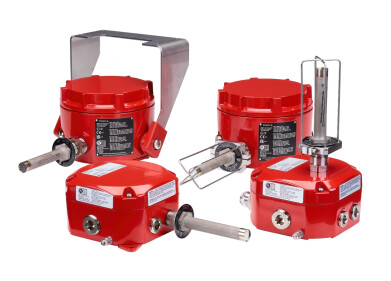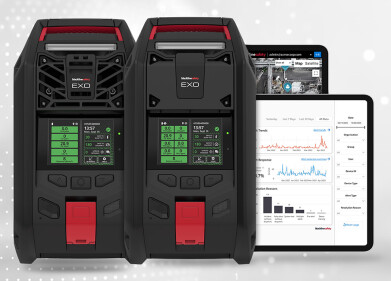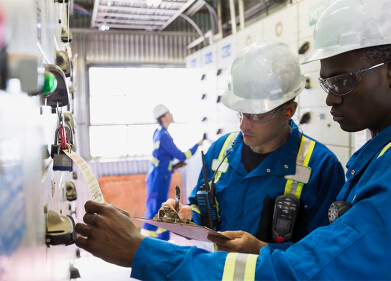Safety
Dropped Objects Lead To Industry Safety Review
Aug 17 2016
Dropped Objects Prevention Scheme (DROPS) best practices guidebook inspires safety hazard management initiatives, including the first re-usable fastener recommended for secondary retention.
Natural disasters such as raging winds and seas may appear to create the greatest risks to offshore oil platforms and gas rigs, however safety related and life threatening accidents continue to plague operations and raise significant concerns with corporate leaders. It’s the growing number of reportable incidents and near misses that occur when overhead objects—equipment and tools— drop from hundreds of feet above a work area due to improper fastening and unreliable means of securing.
Dropped objects present such a significant danger at operational sites—onshore as well as offshore—that a growing number of advocates have pushed for better safety hazard management practices. Unfortunately progress is gradual, in part because of the enormity of the oil and gas entities: these large fleets are sometimes slow to change.
Also, improving an unsafe work environment demands educating a vast web of not just CEOs, but personnel, site managers, and the ancillary companies that design and supply products or provide transportation, installation and maintenance services.
Yet a wave of good intentions and commitment is gaining force.
The initiative began in the late 1990s when offshore companies operating in the North Sea noticed an increase in reportable incidents that included injuries, near misses and deaths related to the unintended falling of overhead objects. Damaged equipment and productivity interruptions certainly provoked concern, but neither of those issues could compare to serious bodily injury of employees and loss of life. Eventually, the industry determined that dropped objects become lethal at specific combinations of height and weight.
The data uptick inspired the beginnings of a global organization focused on safety measures for the protection of offshore workers. A booklet called Best Practices Guide for Offshore Environments was created and shared. It was a relatively short book, but it spelled out the causes of dropped objects and the steps that needed to be taken to prevent catastrophe.
The booklet caught on within the industry, and many companies wanted to implement the life-saving strategies. At that point, recognizing the pervasive nature of the danger, the organization agreed that an independent workgroup was needed to better disseminate the information. That decision led to DROPS.
Failure is not an option
Dropped Objects Prevention Scheme (DROPS) has since expanded the guidebook into a 130-page PDF that addresses safety practices for all operational activities. A free edition is available on its website, www.dropsonline.org. The organization is represented worldwide by 200 operators, contractors, service companies and industry groups. Needless to say, they all share a commitment to preventing the lethal problem of dropped objects.
Since its inceptions, membership has grown to about 2,400 members thanks to annual forums at industry trade shows in Great Britain, North America and Asia. The events allow Original Equipment Manufacturers (OEMs) to discuss their reportable incidents and share their solutions. Also on hand are a few educational presenters, who represent vendors that create safety improvement products, such as engineered fasteners.
Ryan Bostick a STANLEY Engineered Fastening technical sales representative who is a fastening specialist with expertise in both oil and gas industries says the all-day technical sessions have spawned a new program called “Train the Trainers”, wherein DROPS experts offer on-site consultations and instruction. And the organization has also expanded its library and now offers four more books.
“They cover lighting and tooling and basically anything overhead that could fall and injure workers. That’s where STANLEY Engineered Fastening, Spiralock, and others come in,” says Bostick.
One volume called Reliable Securing discusses every form of fastening, including rope, wire, welding and soldering. Another name for this fastening reliability is secondary retention. About 90 percent of the world of fastening recognizes secondary retention as a backup plan for the fasteners to make sure they will not come loose—and create another dropped object incident.
Primary retention on a nut, bolt or tapped hole typically refers to torque. “If you put a nut and bolt together and you torque them to a specification, you achieve primary retention. But what is your backup plan in case the operator fails to torque it properly? What did you do to back that up?” he says.
Another concern is fasteners that loosen as a result of vibration and heat (when adhesives are used) in confined spaces offshore and onshore.
For many years, the conventional method of secondary retention was standard locknuts, bonding agents, or safety wire. They all are reliable and accepted, but they are not reusable. Spiralock® a product of STANLEY Engineered Fastening introduced the first reusable locknut in the world and was added as an acceptable secondary retention device to the DROPS book.
Spiralock also introduced the first thread innovation for fasteners since WWII. Their re-engineered thread form adds a unique 30-degree wedge ramp at the root of the thread which mates with standard 60-degree male thread fasteners.
The wedge ramp allows the bolt to spin freely relative to female threads until clamp load is applied. Bostick says “the free spinning function is important when you are 40 feet above ground attempting to torque down a fastener without falling”.
The crests of the standard male thread form are then drawn tightly against the wedge ramp, eliminating radial clearances and creating a continuous spiral line contact along the entire length of the thread engagement. This continuous line contact spreads the clamp force more evenly over all engaged threads, improving resistance to vibrational loosening, axial-torsional loading, joint fatigue, and temperature extremes.
“When you look in the book you see that every other product is followed by a warning — “DO NOT RE-USE”. Spiralock supplied the first re-usable nut to be introduced into the secondary retention world of dropped objects,” says Bostick.
Best practices, random orders
Despite the obvious importance of DROPS, a certification with mandatory compliance is not yet an industry-wide standard. There still remains a gap between corporate leadership that pledge their allegiance to safety and operators who must work within a budget, and have limited authority to requisition superior, sometimes more expensive fasteners—even though there are potential life threatening risks.
Some experts agree that safety demands a new way of thinking about expenditures. For example, on paper a $0.75 cent fastener appears far more expensive than the product that is available for a mere $0.25 cents. It’s a reality that fastener cost comparisons drive buying decisions; however when total costs are considered and take into account downtime and overtime due to injuries and safety related issues, the math takes on new meaning.
According to industry sources, the average operating cost for an offshore platform is $650,000 per day. Two years ago, before the oil market collapsed, the daily rate was $2.4 million.
The day rate includes every cost required to move a rig from a yard and operate it in the ocean: gasoline, equipment rentals, labor and housing to name a few.
So, if the least expensive fastener fails and all operations stop, at $650,000 per day, every lost minute costs $451. Suddenly that “cheap” fastener looks expensive.
Change may be slow, but that doesn’t mean DROPS is not having an impact in the offshore environment. Bostick says he hadn’t fully grasped the impact of the organization until Spiralock started receiving new orders from around the globe. When he asked those customers why they had made a purchase he learned that the company was listed in the book as an enforcer of the group’s safety guidelines.
Also, he says attendance at the DROPS forums by some of the world’s largest oil companies proves that the organization and its mission is for real and here to stay.
“Some of these enormous companies have actually created DROPS divisions within their own companies. And that’s a good sign,” concludes Bostick.
Digital Edition
PIN 25.5 Oct/Nov 2024
November 2024
Analytical Instrumentation - Picturing Viscosity – How Can a Viscometer or a Rheometer Benefit You? - Sustainable Grease Formulations: Evaluating Key Performance Parameters and Testing Method...
View all digital editions
Events
Nov 26 2024 Paris, France
Nov 26 2024 Amsterdam, Netherlands
Nov 27 2024 Istanbul, Turkey
Biogas Convention & Trade Fair 2024
Nov 27 2024 Hanover, Germany
Dec 03 2024 Dusseldorf, Germany



















